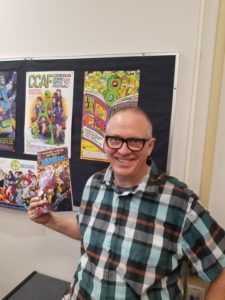When the world becomes a dark, cold, and unforgiving place, people turn to what comforts them. In Canadian author Margaret Atwood’s short story Oursonette, that comfort is comics for protagonist Al Zurakowski. Camosun Comics and Graphic Novels program co-founder and instructor Ken Steacy says Atwood’s story—which is based on a style of Canadian comic books called Canadian Whites—got into him and wouldn’t let him go.
“Any good piece of fiction or literature or art or movies or TV series, when it does have its hooks in you, when you leave the theatre… you’re a little sad because there’s a yearning,” says Steacy. “You want more.”

Steacy decided to try to get in contact with Atwood after being inspired by her story; one thing led to another, and he found himself spending an afternoon with her going over character development for what became War Bears, his comic collaboration with Atwood based on Oursonette.
“Pinch me; I’m dreaming,” he says with a laugh, reflecting on that afternoon.
Steacy and Atwood would exchange emails and meet to discuss the story, and Atwood would provide tweaks in terms of character development and plot. Steacy says he followed the original Oursonette story in this comic adaption, and says that Atwood is a great cartoonist who is a real history buff and deeply invested in Canadian history and Canadian culture and identities.
“But this is what she chose to write about,” says Steacy. “Also, people don’t know this, but she’s a great cartoonist. She’s incredibly funny and does these wonderful little cartoons. It was just very serendipitous.”
Steacy says that, stylistically and thematically, the adaption is in keeping with the original Canadian Whites. It has some black and white pages and some colour, but, first and foremost, it’s patriotic, says Steacy.
“It’s a very Canadian story. When I count my blessings, very near the top of the list is that I’m Canadian. I live and work in the best country in the world. Of course, as a Canadian, you’re not supposed to say that; we’re much too polite,” says Steacy, with a laugh.
Canadian Whites contributed to—if not completely formed—a distinctly Canadian subculture within the comic industry, Steacy says. Both the original and the adaption of the story reflected the time period the nation was in. It was total war, says Steacy.
“The entire nation—everyone—is somehow directly or peripherally involved in the war effort,” he says. “Everyone was pulling together.”
Steacy says Atwood’s original story reflected that. It was about a boy, Zurakowski, who couldn’t serve in the war. He sat at home, ridiculed by those around him for being lazy; he found solace in comic books, and eventually they became his contribution to the war effort.
“This will be his contribution to the war. He will boost morale; his characters will encourage people to buy war bonds… he has a very pure heart,” says Steacy. “The character he creates is also a reflection of his desire to show his support for our allies.”
Steacy says that Canadian Whites became an integral part of the war effort in the story and boosted morale for those on the frontlines.
“It was all about fighting fascism and punching Nazis and all that good stuff,” says Steacy, “but also, of course, there’s a very Canadian flavour to them.”
